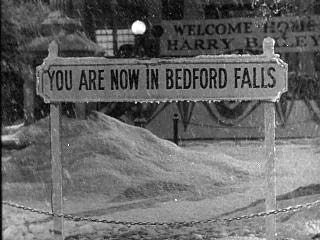Filed under: Film | Tags: Bedford Falls, Capitalism, Ceci n'est pas une pipe, Christmas, film noir, Frank Capra, Gary Kamiya, It's a Wonderful Life, La trahison des images, Rene Magritte

I always disliked Frank Capra’s It’s a Wonderful Life (1946) as a teenager. I couldn’t buy that George Bailey, the intrepid cavalier whose only reward for discarding his lifelong hopes and dreams for conservative family security was not committing suicide and not losing the livelihood he never wanted. I know there’s suposed to be something about the respect of your peers and the triumph of the human heart, but it always seemed rather thin to me. This was eventualy compounded with an innate suspicion that because Paramount ‘forgot’ to renew its copyright in 1974 and let it enter the public domain, it became a “Holiday Classic” simply by virtue that broadcasters could play the movie ad nauseum.
Lately, however, my opinion of the film is changing. I’ve decided that Capra’s film is essentially a film noir in sheep’s clothing. Aesthetically, of course, the film uses many noir tropes: voice overs, flashbacks, chiaroscuro lighting and the cynical irony of Jimmy Stewart. But this style evidences nothing more than perhaps the fashion of the times. What truly establishes It’s a Wonderful Life as a noir is its treatment of the noir subject: the tough, ironic specimen of compromised masculinity who is drawn rather than travels through life, a a passive observer to forces beyond his control.
Gary Kamiya at Salon recently wrote about Capra’s opus, in which he hails the part of the film that is most explicitly film noir: the sultry, urban portrayal of a George Bailey-less world.
In Capra’s Tale of Two Cities, Pottersville is the Bad Place. It’s the demonic foil to Bedford Falls, the sweet, Norman Rockwell-like town in which George grows up. Named after the evil Mr. Potter, Pottersville is the setting for George’s brief, nightmarish trip through a world in which he never existed. In that alternative universe, Potter has triumphed, and we are intended to shudder in horror at the sinful city he has spawned — a kind of combo pack of Sodom, Gomorrah, Times Square in 1972, Tokyo’s hostess district, San Francisco’s Barbary Coast ca. 1884 and one of those demon-infested burgs dimly visible in the background of a Hieronymus Bosch painting.
There’s just one problem: Pottersville rocks!
It sure does. Or at least, it certainly appears to. But what is particularly striking about this section of the film is that Pottersville more closely resembles the ‘real’ America: dehumanizing and debauched, rife unemployment, and criminally overseen by a General Sternwood-esque capitalist magnate, Mr. Potter. Bedford Falls, on the other hand, the ‘reality’ of the film, comes across as an eerie dream world of community, fraternity and equality (albeit with a creepy dose of privacy forfeiture). This dream world pales in the context of postwar America where a generation of men are searching for their identity, women are searching for their rights, and the capitalist state apparatus is violently rebuking such ideals at every opportunity in the face of the communist menace. Indeed, there is something powerfully unsettling about the film’s opening shot that brazenly declares to the viewer “YOU ARE NOW IN BEDFORD FALLS” when we know, emphatically, we are not. Its uncanniness rivals Rene Magritte’s famous ‘Ceci n’est pas une pipe’.
Ironically, Bailey’s ‘dream’ world—that is, one where he has left Bedford Falls for college, travels or the war (!)—is the same as the one where he dies (paging Dr. Lacan). It’s also the real America. Essentially, America has dreamed itself, mediated by Bedford Falls where we all (do not) reside. Suddenly, we see the emergence of the noir universe, in which we are parasitic stowaways to our own capitalistic fantasies. How appropriate, then, that in the inflated consumerism of contemporary Christmas, this ‘wonderful’ film has monopolized our holidays by virtue of its repeatability, marketability and libidinal bribery.
Kamiya certainly notices this, although his conclusion is perhaps less jaded than my own:
I have made, I believe, a definitive case that Pottersville has gotten a bad rap and that Bedford Falls is grossly overrated. But if there are any who are still unconvinced, I would just like to remind them of one little detail: in the real world, Potter won.
We all live in Pottersville now. Bedford Falls is gone. The plucky little Savings and Loan closed down years ago, just like in George’s nightmare. Cleaned up, his evil eyebrows removed, armed with a good PR firm, Mr. Potter goes merrily about his business, “consolidating” the George Baileys of the world. To cling to dreams of a bucolic America where the little guy defeats the forces of Big Business and the policeman and the taxi driver and the druggist and the banker all sing Auld Lang Syne together is just to ask for heartbreak and confusion when you turn off the TV and open your front door.
So don’t fight it. It’s a Pottersville world! Welcome jitterbuggers! Get me — (ka-ching!) — I’m giving out wings!
On my last watching of It’s a Wonderful Life I found myself really, truly enjoying it, both its preciousness and its stylistic gall. Perhaps Kamiya’s solution is the best one. If you’re offering a two-for-one Boxing Day sale on wings, I’ll be the first to queue up.
hat-tip to Julio


